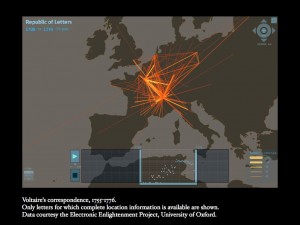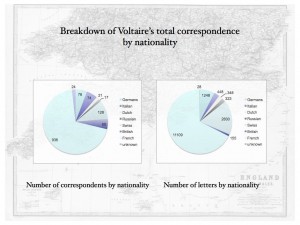The Mapping the Republican Letters project, run by Stanford and several other academic institutions, has the goal of recreating the network of correspondence before email, social networking, and even the telephone. For centuries before texting, information traveled in these networks created by academic institutions and carried out by travelers on the fast trade routes.
One of the case studies follows Voltaire. This case studies looks at several important parts of Voltaire’s writing, including whether it was regional or international, whether he was truly capable of having a global network, and whether he wrote to some places more than others. Below, the project uses mapping to show his correspondence from 1755 to 1776. Mapping is the primary DH approach used for both this case study and the whole project. This method fits the project perfectly because it is trying to show how fast these networks really were.
Below is a breakdown of Voltaire’s total correspondence by nationality and number of letters per nationality. He sent most of his letter to French correspondents. Although he had about the same amount of British as German and Italian correspondents, he sent them less letters. Almost one third of all the letters sent to England from Voltaire were to either George Keate or Sir Everard Fawkener. Voltaire sent 38 and 23 letters to each of these men, respectively.
Another interesting point is that although Benjamin Franklin and Voltaire never came in contact as far as they can tell, they have many correspondents in common. This begins to show how vast the network was during this time even with the lack of global communication. Because of the vastness of information that was sent during this time, it is very difficult to track all of it let alone represent it using interactive visualization tools. As well as the Voltaire study, the website has links to many others, such as Galileo, Franklin, and Kircher.

